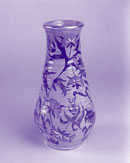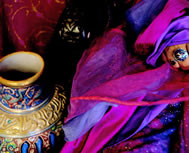




 |
    |
Reviews |
||
 |
Hia MagazineSomewhere in between East and West - Interview by Rana Haddad Carolinda Tolstoy is a well-known London ceramicist, who has managed to make her art a mirror of her life and imagination and a charmingly painted ceramic bridge between east and west, between the now and the then. Although she is classically English in educational and social terms, Carolinda's ancestral roots are Greek. From her voice - after our initial telephone conversation - I imagined her to be a classic 60s-child English woman with bohemian blonde hair, blue jeans stained with paint and clay and perhaps a cigarette in her mouth. Instead, the woman who opened the door for me had the looks of an ancient oriental princess, with jet-black flowing hair, almond shaped khol-ed eyes, dressed in wild and exotic silk draperies. When I finally saw her pottery I realised that Carolinda almost looked like one of the Persian characters which she so loves to portray, that she, her life and her art were one. Her love of cloth, silk, materials, lines and creases is expressed in her style of pottery making, where creases and soft outlines are major features of the forms she paints on the fired clay. Her human figures look like flowers almost, they have no bones, and they are liquid, dreamy, soft and look as if they live inside the clothes they are wearing. Of course what is most noticeable apart from these undulating soft forms is her love of exuberant colours: especially the colours pink and gold. When I asked her about that she replied humorously: "I like to look at the world through rose tinted glasses." It was no accident then that she was actually wearing pink lenses. Not only are her glasses and much of her painted pots pink, but if you look around her beautiful London house, you'll not fail to notice, that the blinds, the couch, many of the walls and even the tables are positively fuschia. Looking around it is obvious that Carolinda's talent is not only confined to ceramics. Her joy in the visual is so strong that her whole house reflects her taste and vision. Her bedroom has paintings of olive trees which she has executed herself, to remind her of Greece, whilst her garden is full of small pottery lanterns of her own making, hanging from the tree branches, containing small fragrant candles to light her many summer parties. When I came to see her she was preparing for a dinner party and among the numerous delicious foods and drinks she had prepared there was a set of Arabic coffee cups which she had finished 'cooking' the night before. Not only does she cook her food, but also her cups and saucers! After studying fine art in Paris in the 1960's Carolinda returned to London where she joined the Chelsea Pottery and learned traditional ceramic throwing and glazing techniques. While her contemporaries were working on minimalist modernist decorative pot and ceramic designs, she was silently and mysteriously drawn to oriental decoration. This was not particularly fashionable at that time and so she had to discover the beauty of the East on her own during her frequent visits to the Victoria & Albert Museum in South Kensington. Amongst the wealth of ornaments and decorative works from all over the world, Carolinda was immediately drawn to Islamic geometric designs, with which she first became inspired, sometimes borrowing, sometimes innovating - but always experimenting. Starting with abstract geometric forms, she then moved on to stylised and curvaceous flower, petal, plant, tree and grass forms, making pots which were popular in some of London's biggest luxury stores and highly sought after in a long list of exhibitions and shows throughout London, Paris and Greece. After a ten-year break (while she brought up her three children), Carolinda's artistic forms and interests metamorphosed once again - this time she moved from flowers to human beings. She was inspired by the work of a famous Safavid Persian Miniature painter, whose name she didn't yet know (Riza-yi 'Abbassi, circa.1565 - 1635). From her studio - in the back of the garden - a tradition, which started in sixteenth and seventeenth century Persia, is being continued. Who would have thought that a woman in late twentieth century England would carry the banner which the famous Persian Painter Riza-yi 'Abbasi had first started and that she would convert his miniature paintings into ceramic pots, much loved by contemporary British and international buyers. What is noticeable and most fascinating about those human forms and part of the reason Carolinda loved them, is that they remind her of flowers and oriental calligraphy, swaying and undulating, with shoulders, bellies a sensual sensitive contemplative stance. Which is beautifully reflected in the rounded shape and smooth texture of pottery. This is what was striking about the original Persian work and what Carolinda continues to portray and give form to with a touch all her own. Recently Carolinda's work was noticed by the British Museum's Assistant Curator of Oriental Antiquities (Dr. Sheila R. Canby) who was shocked to find a contemporary woman ceramicist whose work was directly inspired by a Persian Safavid Court painter of the sixteenth and seventeenth century who she was an expert on! Her pots (as you can see in the pictures) speak for themselves: Beautiful, exquisite and there to stay. They are but a small testament to the power of beauty - how it can build bridges between cultures, people and ideas. Carolinda sees the same spirit and essence of design in the Cupolas of Eastern European Russian architecture and Islamic Turbans. With the same energy to paint, decorate and beautify which drives her to paint pots, plates, vessels, even stones and living fruit (such as the skins of pomegranates). This is what makes her work special and enduring. In 1975 Carolinda finally travelled to Persia and saw the seeds of her art's inspiration at first hand, she also travelled all around the ex-USSR Caucasus, Bokhara, Tashkent, Khiva and Samarkand. Although her love for the East was purely a visual one it grew afterwards into a deeper knowledge based on reading, travelling and with many contacts with Persians, Arabs, Turks and Andalusian Spanish influences. Although Carolinda was only exposed to the East in Museums, she later learnt a lot at first hand. Perhaps something in her Greek roots draws her unconsciously to southern cultures. Her husband is originally Russian, his family having escaped Russia after the Bolshevik revolution in 1917 - and yes he is related to the famous writer of War & Peace, Leo Tolstoy. Even Eastern European Russian influences can be glimpsed in some of her work. Carolinda finds a mysterious link and similitude between Russian art and Persian art which certainly had been fed through international trade routes running through Central Asia and connecting the Empires, making a cross cultural exchange.
|
 |
| © Carolinda Tolstoy 1999-2018 | Web site design: QuincDigital |